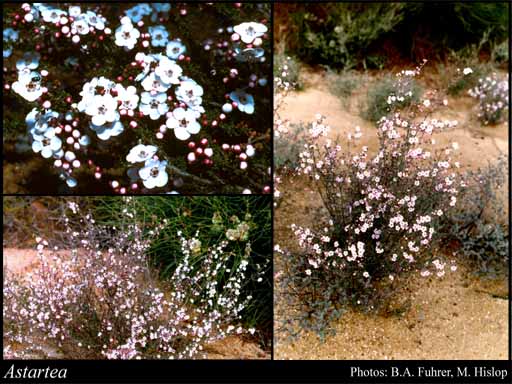- Reference
- Prodr. 3:210 (1828)
- Name Status
- Current







Scientific Description
Family Myrtaceae.
Habit and leaf form. Shrubs, or trees (rarely); evergreen; bearing essential oils. Plants with neither basal nor terminal concentrations of leaves; to 0.4–7 m high. Leptocaul. Helophytic to xerophytic. Leaves minute to small; opposite (or in opposite bundles); decussate; ‘herbaceous’, or leathery; shortly petiolate; gland-dotted; aromatic; edgewise to the stem, or with ‘normal’ orientation; simple; epulvinate. Leaf blades dorsiventral, or isobilateral, or centric; entire; flat, or solid; terete, or semi-terete, or solid/angular (triquetrous); linear, or lanceolate, or oblong, or ovate; linear, or ovate; pinnately veined, or parallel-veined, or one-veined; cross-venulate, or without cross-venules. Mature leaf blades adaxially glabrous; abaxially glabrous. Leaves without stipules; without a persistent basal meristem. Leaf anatomy. Hairs absent. Stem anatomy. Secondary thickening developing from a conventional cambial ring.
Reproductive type, pollination. Fertile flowers hermaphrodite. Unisexual flowers absent. Plants hermaphrodite. Entomophilous, or ornithophilous. Pollination mechanism conspicuously specialized, or unspecialized.
Inflorescence and flower features. Flowers solitary; axillary; pedicellate; (bi) bracteolate; small to medium-sized; regular; 5 merous; cyclic. Free hypanthium present (petals ‘inserted on the calyx’); campanulate, or turbinate. Hypogynous disk present. Perianth with distinct calyx and corolla; 10; 2 -whorled; isomerous. Calyx present; 5; 1 -whorled; polysepalous, or gamosepalous (depending on interpretation); imbricate; exceeded by the corolla; regular; persistent. Corolla present; 5; 1 -whorled; polypetalous; imbricate; regular; white, or pink. Petals obovate to orbicular. Androecial members definite in number, or indefinite in number. Androecium 5–40. Androecial members branched, or unbranched. Androecial sequence determinable, or not determinable. Androecial members if ‘many’, maturing centripetally; free of the perianth; all equal, or markedly unequal; coherent; 1 - adelphous (connate into a continuous or discontinuous ring), or 5 - adelphous (in bundles). The androecial groups opposite the sepals. Androecial members 1 -whorled. Stamens 5–40; remaining included (exceeded by petals); isomerous with the perianth to polystemonous; alternisepalous and oppositisepalous, or oppositisepalous; both opposite and alternating with the corolla members, or all alternating with the corolla members; erect in bud, or inflexed in bud. Filaments filiform, or strap-shaped (the anthers attached to the front of the filaments). Anthers all alike; dorsifixed; versatile; dehiscing via longitudinal slits; introrse; tetrasporangiate. Gynoecium 2–3 carpelled. The pistil 2 celled, or 3 celled. Gynoecium syncarpous; eu-syncarpous; inferior, or partly inferior. Ovary plurilocular; 2 locular, or 3 locular. Epigynous disk present, or absent. Gynoecium stylate. Styles 1; simple; from a depression at the top of the ovary; apical. Stigmas 1; capitate. Placentation axile. Ovules 2–10 per locule; ascending; non-arillate; anatropous.
Fruit and seed features. Fruit non-fleshy (woody); dehiscent; a capsule. Capsules septicidal, or loculicidal, or denticidal, or circumscissile. Fruit 2–3 celled. Seeds angular; non-endospermic. Cotyledons 2.
Geography, cytology, number of species. Native of Australia. Endemic to Australia. Australian states and territories: Western Australia. Eremaean Botanical Province and South-West Botanical Province.
Etymology. Named after Astarte, a Syro-Phoenician goddess, equivalent to Venus; the myrtles, of which this is one, were sacred to Venus.
Keys
A Key to Western Australian Species in the Chamelaucieae Tribe of Myrtaceae
B.L. Rye, M.D. Barrett, T.D. Macfarlane, N.S. Lander, M.E. Trudgen, N.G. Marchant, K.R. Thiele
Taxonomic Literature
- Wheeler, Judy; Marchant, Neville; Lewington, Margaret; Graham, Lorraine 2002. Flora of the south west, Bunbury, Augusta, Denmark. Volume 2, dicotyledons. Australian Biological Resources Study.. Canberra..
- Marchant, N. G.; Wheeler, J. R.; Rye, B. L.; Bennett, E. M.; Lander, N. S.; Macfarlane, T. D.; Western Australian Herbarium 1987. Flora of the Perth region. Part one. Western Australian Herbarium.. [Perth]..
- Blackall, William E.; Grieve, Brian J. 1980. How to know Western Australian wildflowers : a key to the flora of the extratropical regions of Western Australia. Part IIIA. University of W.A. Press.. [Perth]..